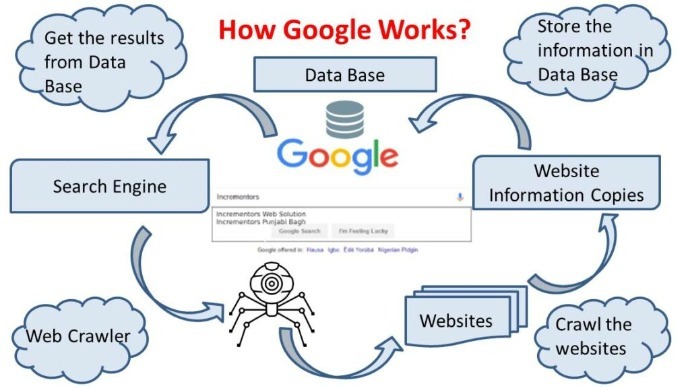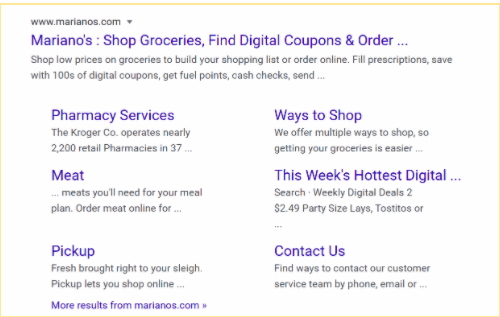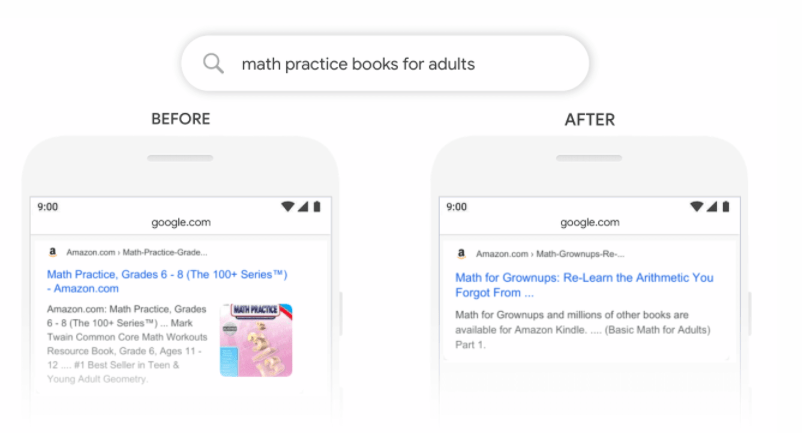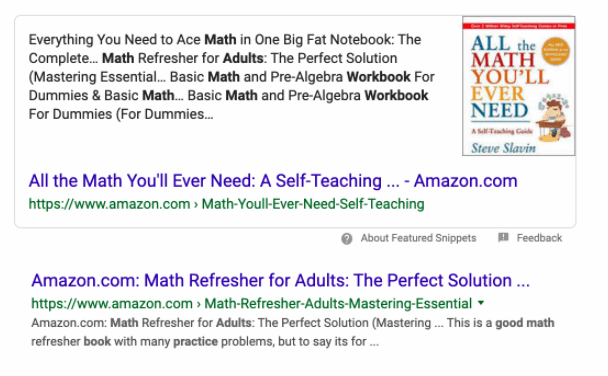Why is Google’s New Algorithm Important for Your Business?
The newest algorithm update, DeepRank, was officially launched in October 2019 and became fully live at the end of October 2020. DeepRank is building on previous algorithms to create a more advanced search engine.
Did that say algorithm?
Get ready for some math class flashbacks.
Despite the flashbacks, everyone needs to recognize how to maximize search engine results pages (SERP) to reach a larger target audience. There are many moving pieces in building an algorithm.
So, the focus needs to be on what Google is updating is the key to getting good graces with Google’s search engine.
As long as my target audience finds my website that is what is important right? Not exactly.
The value is understanding what content is coveted by the user (the person doing the searching) and how the user will interact with the content.
The goal of your marketing strategy is to engage with your audience.
What will promote interaction and engagement with your website? (I hope you are not using a search engine to figure out how to get back at me for making your head hurt.)
Let’s Start with Search Engine Basics
Simply think of a search engine like an equation. (Sorry for more math.)
Database of Information + Algorithm = Search Results
That does sound too complicated. Now let’s look at how it works.
The Internet bot or crawler searches the Web for content related to the user’s search query. As information is collected, the crawler is simultaneously looking for new content along with going back to previously known content. Once the relevant content is found, it is collected in a database.

According to Hansikar, from the database, content is identified based on the level of relevance then ranked accordingly.
This is where SERP becomes important.
You want the user to interact with your website and engage with your brand. You want your search results to be the one the user sees. The more they see and click on it, the better it is for your website. Voilà!
So, How Does Understanding Human Language and the New Update Important for Google?
While Google makes adjustments and tweaks regularly, this update is designed to focus on language content, and how easily the content appears for the user.
DeepRank was designed to better understand natural human language, and treat websites that embrace how users search for queries (in the search box) to how the content matches those search results.
This is in simple terms here. If a user searches for a query titled “How can I swell up my arms, a detailed piece of content that explains how to grow your “guns” would rank favorably because it matches a query that consistently comes up. Who doesn’t want big “guns?”
Alright, how can you apply some EASY FIXES to account for this recent update?
Tip # 1: Call to Action: Optimize and Personalize Your Content
With the recent update, Google has a better understanding of context, and continually learns how the psychology behind a user search “works.”
Your content goals can truly center around being clear, focused, and purposeful. Google has made it evident to its users that it understands the relationship between words similar to how humans understand.
Google’s algorithm shifts the focus from the sequence of words to the whole sentence.
The ability to better understand the context of language will lead to users receiving more relevant content. It is that content that will allow a user to interact and engage with your business.
That means that your content needs to align with the actual needs behind why they need your product or service.
Do you have a buyer persona?
In order to give the user meaningful content, you need to know who your audience is. Design your buyer persona using research you already have at your fingertips.
Going back to one of our favorite tools Google Analytics. This is a greeting starting point because it can be used for your website, social media insights, and existing consumer data. Don’t reinvent the wheel.
Also, review your social media insights and see what behavior you can identify with what content sparks the most engagement (shares, likes, comments), and use the insights within each platform. You get a lot of information just with applying time alone.
What should your buyer persona look like?
Create a buyer persona that is authentic, not hypothetical. Think about who is your target audience. Think about what your typical customer not only wants/needs but doesn’t want/need.
And don’t forget to consider where your customers spend their time online. This creates the foundation for your buyer persona. Furthermore, it’s a great guide to provide creative guidance to your writing team because the “guidelines” are already there.

How can you ensure your business is optimizing content for your buyer persona?
Here are some questions you can ask yourself.
Humanizing Your Content
- Does the content tell a story that highlights the mission and vision of your business?
- Does the content allow your target audience to connect in an authentic way?
Creating Value
- Does the content anticipate the needs and wants of your target audience?
- Does the content demonstrate the benefits of your product/service over your competitors?
Keep in mind you may be able to answer the questions but are you answering the questions that relate to connecting with them on their needs for your product, both tangible (benefits) and emotions (why your product or service will help them on a deeper level…think saving time, money, reputation, etc).
Look for a future blog post addressing the call to action questions above.
Tip # 2: Answer the Question Before it is Asked: Design a Relevant Featured Meta description/Snippet that Answers the User Query
As previously mentioned, Google wants to give users relevant information. With that in mind, you need to turn your attention to a purposeful featured snippet that will encourage users to interact and engage with your website.
Can you build a connection with the user? The answer needs to be yes.
A featured snippet is a description a user sees when they type a query into a search engine.
A meta description (meta for short, 150-160 characters) is a line of text that appears underneath the website on the search results.
Sounds very simple and easy to do. Keep in mind first impressions are important. What impression will your featured snippet make?
Take a look at a small business in the Chicago area.

I can personally attest to the deliciousness you will find at George’s. I highly recommend my absolute favorite Zanzibar. (Now I am hungry.)
Based on my personal experience, I can tell you that the featured meta above is right on target.
There is a whole lot packed into the meta. Look at word choice.
- Imagery words: comfy/neighborhood – tells the user about the ambiance
- Appeal to taste: classic/unique – great an interesting flavors of ice cream
A closer look at the description, you will notice that descriptive words are used naturally in a complete sentence. There was a purpose for those descriptive words. Not only to want ice cream (I mean who doesn’t want ice cream.) but to want their ice cream. Go to their website, you will see content and images that show the featured snippet is spot on.
Each business’ featured meta is different but serves the same purpose. They should drive traffic to your website through an organic search result and maximize your search engine optimization (SEO) strategy.
Now take a look at a larger business that is throughout Illinois and notice the difference.

Read the first line and you are going to find keywords that connect to your target audience. The purpose here is to want to shop at their store.
- Shop low prices and digital coupons – acknowledges you have a budget and want to spend your money wisely
- Order online – offers convenience and the time of a pandemic it can make you feel safe
Remember, the new algorithm is recentering its focuses on the content as a whole. Reread the first sentence. It is not a list of random words. It is a complete thought and would match several queries. The meta is using natural human language.
If you look at Mariano’s sublinks, they also directly answer possible search queries and support the content on their website.
- What are grocery stores near me that deliver or offer pick up?
- What grocery stores near me are inexpensive?
Look at your own buyer personas and make sure they answer the following questions.
- Would he/she find it compelling?
- Do the keywords show the value of going to your website?
- Does it connect to your needs or more specifically your buyer persona?
- Is the content clear and direct?
Tip # 3: Determine the One or Two Keywords You Want in the Snippet
At this point, you understand the goal of the new algorithm is to produce the best results of the query.
But what you need to do is write a better snippet.
You must write a snippet that utilizes natural human language.
For example, a user needs to brush up on his/her math skills. (No worries I won’t make you solve any equations.)
He/she does a search for “math practice books for adults”. A previous search would give the user books for math but not necessarily for adults. The screen shot below provides an illustration.

A Snippet Example
While you may feel you need the 6th to 8th-grade math book, what you really need is the book on Math for Grownups. Now let’s look at the feature snippet and keywords that reflect natural language.

If you examine the snippet, your first observation will be there is an emphasis on “math”. This is logical based on the search query.
However, the main reason that the featured snippet appears is the type of language used. It uses language that is geared towards adults and not children.
With the new focus on human language, the algorithm is now better able to match the user’s intent which in this case is math for adults. As a result, there is more potential for increased interaction and engagement with your webite.
Summary
When you think about algorithms, it can seem confusing and a little frustrating. However, you don’t need to understand the algorithm. Rather you need to understand what it does. And most importantly, recognize what it does for your business. Content is key in Google’s newest update, so you should work to humanize your content as best you can.
- Always focus on the personalization of your content to engage your target audience.
- Do the research on what your buyer persona needs. We explained this in more detail in the post. Answers to those questions should be present in your content.
- Over time, Google will recognize your content connects with what a user searches for, increasing the relevance of your brand and website with a minimal technical focus.
- Use keywords that will attract your target audience so they will interact with your website. There are several ways to do this, … perhaps a future blog post?
- Snippets and metas are excellent uses of real estate to connect users to your brand. Make sure your snippets and metas are written to answer the WHY you have discovered when developing your buyer personas.
These easy fixes will allow you to maximize Google’s new algorithm to your advantage. Your competitors understand the importance to their business. Don’t let your competitors take the lead by implementing these easy fixes first.





0 Comments